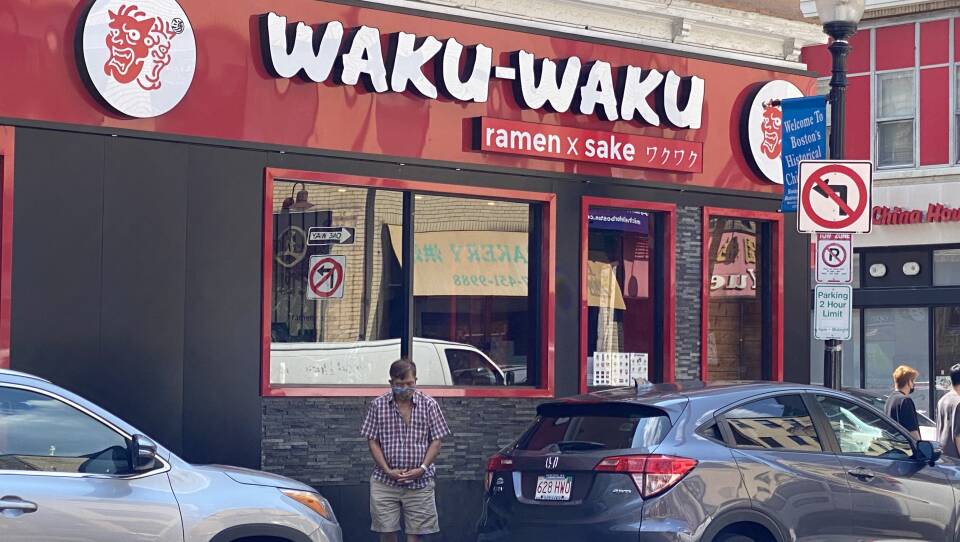In 2019, Menya Jiro announced it would be expanding to Boston. In July, the Japan-based ramen chain opened its Harvard Square location, and there are currently plans to open two more: one in Dedham, and another in the Seaport District.
The circumstances that brought Menya Jiro to Eastern Massachusetts were of the “right place-right time” variety. Linda is one of the partners in the Boston location. (She wouldn’t give her last name. We’re rolling with it.)
“We have a partner who has a hand in Vietnamese cuisine [and] she went to this outdoor event where the neighboring tent was ramen,” said Linda. “They were like, ‘Come to New York and let’s talk more about Menya Jiro, or ramen in Boston.’ And then that’s where it all triggered.”
The partner — Thuy Huynh — made the 200-mile journey south from Boston to New York, where she met the Menya Jiro team and learned all there was to learn about ramen. Expansion talks followed. “Mr. Jiro was all for it,” remembered Linda. “He was like, ‘I’ll help [Thuy] with every step of the way. She can be our leg in Boston.’” Linda says it was chef Jiro Anma’s confidence that cemented the plan, and it was then that Thuy decided to be “true to the brand” and plan for three locations in the greater Boston area. (Menya Jiro operates by the rule of three: three locations in Japan, three in New York).
It’s not a stretch to say Boston is punching above its weight on the ramen scene, and Menya Jiro is far from the first outfit to launch eateries during the city’s Ramen Renaissance. For the past decade, a number of ramen restaurants — ranging from hole in the wall to hyped up — have been springing up in the Boston metro area. There’s Ganko Ittetsu Ramen (2015), Pikaichi (2017), Tsurumen (2018) and Isshindo Ramen (2019), to name a few. The past few months have seen the arrival of Zuru Zuru (December 2020) and WakuWaku Ramen & Sake (June 2021). Visitors to the area will find no shortage of lists detailing the city’s best ramen offerings. The whole reason this subject began to interest me is anecdotal, but relevant nonetheless: In Back Bay, I noticed four ramen restaurants in four square blocks. What I found, with a closer look, was an industry full of contradictions.
It may be impossible to pinpoint exactly when the renaissance began, but looking at the opening dates of several mainstays, the shift was underway by the beginning of the decade. Linda remembers that era fondly, thinking back to 2010 when she would meet with a Japanese-cuisine-infatuated crew, crowding into a ramen joint near Lesley College. A few years later, in 2015, she was standing in line at Santouka Ramen’s Harvard Square outpost (just a year before the Japanese chain opened another location in Back Bay). “There was this line out the door every day, rain or shine, snow, any time,” she recalled. “I would circle the block for parking. There was always a line out of this place, and after that, I started seeing ramen places pop up in the vicinity.”
Based on that timeline, one of the earliest institutions to kick things off would be Yume Wo Katare, which opened in Cambridge in 2012. Manager Jake Vo is careful to avoid the term “restaurant” or even “shop” to describe the operation. “Yume Wo Katare is not actually a ramen shop,” Vo specifies. “It’s a dream workshop. This is a place where people think about their dreams while they eat ramen, and at the end of the meal, they stand up and then they share that dream with the entire restaurant. I curate an experience here.” He isn’t shy about claiming Yume Wo Katare to be the institution that set off Boston’s ramen boom.
There’s a chain reaction Vo describes when thinking about the recent proliferation of ramen in Boston. “My master, Tsyuoshi Nishioka, came over here [from Japan]. He opened [Yume Wo Katare] and it’s very inspiring for Japanese people,” Vo explained. Vo says this prompted a surge of chefs to try their hand in the Boston area, as the already existing shops proved successful. “For example, Tsurumen, he's from Japan and is good friends with us. He came over here. And then because all these Japanese people came here to make really good ramen, the industry is saying, ‘Whoa, there’s this increasingly good ramen scene. Let’s jump on this.’”
With a booming ramen scene comes a booming ramen community. Vo said that if five shops open near Yume Wo Katare, he doesn’t necessarily see that as competition. “I see that as an opportunity for me to increase my quality and an opportunity to increase each other's quality,” he said.
All of this makes one wonder why the past decade or so has seen such a flurry of ramen activity. And though Boston-born chef and MIT alum J. Kenji López-Alt says he missed out on Boston’s ramen awakening (he currently lives in Seattle), he still has a few ideas about what conditions had to be met in order to spark a ramen craze. In his estimation, it all comes back to the 2008 supreme mortgage crisis and the subsequent toppling of the American economy. During the recession, Kenji argued, fewer people could afford fine dining. So the industry changed. “You have this whole industry of people who are used to thinking about food in one particular way, but now their product is not really wanted anymore, so what do they do? Transition to more casual endeavors.”
In the aftermath of ‘08, chefs scrambled to apply their skills to something customers would want and could afford. “Ramen, I think, filled an easy niche for people who used to maybe go out and spend 130 bucks on a tasting menu and didn’t have that kind of money to throw around anymore,” he speculated. “Ramen is like one of those things where it’s relatively cheap, you know — maybe, these days, it’s probably like $15 to $18 a bowl in a city like New York or Boston.” This change in approach didn’t only affect ramen: Kenji said burgers underwent a similar process, and we take them much more seriously now than we did 20 years ago.
But the appeal of ramen goes beyond cost. If you’ve ever tried to make the dish at home, you will learn that it is neither an easy task nor one for the faint of heart. Preparation of the broth, for instance, is a labor-intensive process that requires a watchful eye and constant adjustment. Professionally, it’s a perfect intersection: It’s space for chefs to do their thing, and for casual diners and serious foodies to slurp up in awe. “There are a lot of rabbit holes to jump into when it comes to ramen,” said Kenji.
New York City’s regional influence in the Northeast is also something to consider. It’s a bit of a food capital, and Kenji says trends tend to radiate out from there to other metropolitan hubs like Philadelphia, D.C. and, of course, Boston.
Like many other cities, Boston has experienced waves of gentrification, and that sudden influx of cash lends itself to keeping these newer restaurants afloat.
This isn’t lost on Kenji either. He recalls a period of time, specifically in Central Square and Kendall Square, that looked... very different from now. While it’s tempting to latch onto the symbolism of college kids who once ate cheap packs of dried ramen out of kitchenette microwaves now slurping bowls of the stuff from chefs who care about the craft, Kenji points out the plainer fact underpinning it all: “MIT put in a ton of money, and built new stuff and renovated the whole area.” Quite simply, there’s more money in these areas now as opposed to a generation ago, and that’s more disposable income to spend on dining, even if it isn’t a white tablecloth dinner straight out of Pretty Woman.
The power of the nouveau riche (or displaced) dollar, then, isn’t the only factor driving the trend: Boston has colleges, and colleges have people. And everything in colleges looks a lot different now than it did a few decades ago. For Linda, this is the single reason why the restaurant industry can’t afford to slack off in their offerings. “We have so many people coming in from different countries and states, it’s just so culturally diverse,” she said. “I feel like if we bring something that is generic, something like back in the day when we went to chain restaurants ... I don’t think those will do so well with the type of clients that we have now.” It comes full circle, if you choose to look at it that way: after ‘08, a lot of folks started taking “convenience food” more seriously, in line with the ramen trend.
It might appear strange on the surface that ramen is both “relatively cheap” but also a more upscale or refined dining option. But it’s really not: Such a contradiction is the stuff gentrification is made of. Ramen is “essentially like fast food in Japan,” said Kenji. “That’s what ramen was and largely still is. It’s something you get at the train station. You sit down for like 10 minutes and you slurp up a bowl and that’s it.” A good bowl of ramen can easily be had for under $20, but that $20 bill is still a lot of money for the folks that are being driven out of these increasingly upscale communities. You know the look: luxury apartments buildings towering above older dwellings; a bevy of food options instead of the errant McDonald’s; a place where you can hail a cab or get an Uber to come pick you up in minimal time.
“I think my mom was sort of surprised when ramen became like this trendy, fancy thing because, for her, ramen was like fast food,” said Kenji. “She’s like, ‘Why are people, like, waiting in a line before a restaurant opens, to stand in line for two hours to get a bowl of ramen and pay $20 for it?’ It was just, like, a surprise to her.”
But Linda would be hard pressed to imagine a world in which ramen takes pole position on Boston’s famed-food scene. “I don’t know if there’s any other type of cuisine that can replace that signature lobster roll or clam chowder,” she said. She thinks ramen is primed to have a good run in Boston, though. “I just feel like Boston has a population that’s very forward thinking,” she explained. “And so I feel like the people here are more open to it, really embrace these types of foods and the authenticity behind it.”
Vo, though, is even more optimistic. He does believe Boston can achieve “ramen town” status. “I would like to create a ramen culture where all the ramen chefs are connected with each other,” he envisioned. “Where we are constantly improving the quality of our ramen and competing with each other to raise each other up and have everyone have a good, quality product.”








